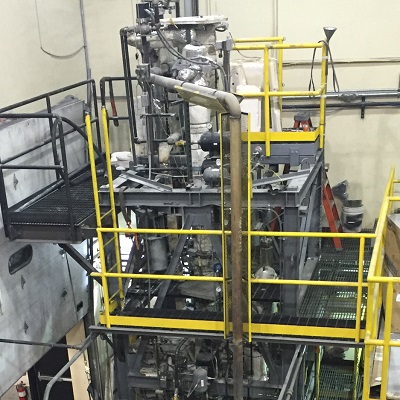Hydrogen. The simplest element in existence – consisting of one proton and one electron, if you remember your secondary school chemistry lessons. It is also one of the most abundant elements in the earth’s crust. However, because it is lighter than air, and as a result rises into the atmosphere, it’s not found naturally as a gas and must be produced from compounds that contain it.
Hydrogen as an energy source
Hydrogen and energy have a long shared history, from powering the first internal combustion engines over 200 years ago to becoming an integral part of today’s refining industry.
Hydrogen is a vital compound that goes into the production of fertilisers and chemicals, as well as an essential reactant for many processes. The demand for low-carbon hydrogen is expected to increase significantly in the future, as it is used to decarbonise the gas grid, industry, power generation and transportation.
The 2018 Climate Change Committee report on Hydrogen in a low-carbon economy, highlights that alternatives to carbon-based fuels will be required across the energy system: not just in electricity generation, but also in our buildings, industry and transportation.
Key facts
- Hydrogen produces no direct emissions of greenhouse gases or pollutants, and can enable renewable energy sources to provide an even greater contribution.
- It is a high efficiency fuel that can be used for heating, power generation and transportation.
- It is particularly of benefit to communities where it is difficult to use electricity - in some circumstances it can be cheaper to transport hydrogen by pipeline than send electricity through the wires.
- Hydrogen can help us tackle energy challenges by offering ways to decarbonise a range of sectors such as transport, it can also help us reduce emissions and strengthen the resilience of the electricity grid.
- Technologies are already available to produce, store, move and use hydrogen in different ways.
Now is the moment for the UK to move decisively beyond the successful decarbonisation of electricity into a broader strategy for the energy, industry and transportation sectors. Hydrogen is becoming an important part of our clean energy future, and as a result there is a political momentum behind it with policies, such as the UK Government’s Net-Zero 2050 target, and projects around the world investigating ways to scale up technologies and bring down costs.
Leading the development of a low carbon hydrogen production process
Cranfield recently led a consortium of organisations, GTI (an energy focussed R&D company from Illinois, USA) and Doosan Babcock (a leading engineering company based in Renfrew, Scotland) in a successful £7.5 million proposal to the UK Department for Business, Energy and Industrial Strategy concerning low cost bulk hydrogen production.
Within this second phase of the HyPER project, the team will demonstrate key aspects of its scale up to the MW scale, by constructing a state-of-the-art 1.5 MWth pilot plant at Cranfield University to test an innovative hydrogen production technology.
The approach is potentially revolutionary for the industry and could lead to a new cost-effective method of producing large scale hydrogen, without the Carbon Dioxide (CO2) emissions. It combines Cranfield’s groundbreaking work in carbon capture via the calcium looping process, with steam methane reforming, to implement a new more effective andlower cost process that can assist the UK in meeting its Net-Zero target.
New process could be more efficient and reduce costs by 30%
GTI’s innovative hydrogen production technology inherently captures CO2 during the hydrogen production process, and shifts the chemical reactions to favour the production of more hydrogen. The process combines the exothermic CO2 capture carbonation reaction with the endothermic steam methane reforming reactions, which reduces the need to burn natural gas to produce heat to sustain the core process and therefore enables us to reduce emissions.
As well as offering the opportunity to improve overall process efficiency and reduce emissions, an additional benefit is that the hydrogen purity from the process is expected to be high, >90%, therefore requiring simple commercially available gas clean up to achieve three or four nines purity – over 99.9 percent purity.
Another key benefit is that it could be more economical than other technologies as the product streams are pressurised. It has the potential to produce high purity hydrogen at up to a 30% lower cost than conventional steam methane reforming methods, that require CO2 capture as an additional expensive process step. Conventional technology is also limited in the portion of CO2 emissions that can actually be avoided with reasonable economics.
The process for the direct production of hydrogen from natural gas that will be used in the project is compact yet scalable to very large plants. The pressurised operation offered by the process points to a very competitive levelised cost of hydrogen (LCOH). Phase 1 of the HyPER project showed that as a result of the sorbent enhanced reforming process the LCOH could be significantly lower-20% lower than that attained in alternative processes. Importantly, the capital investment per plant is significantly lower and the physical size is much smaller than the alternatives, making the likelihood of commercial deployment much more practical.
We’re optimistic that the system under development will be relatively low risk, highly efficient, and will offer a step change in the industry’s capability to provide high volumes of hydrogen.
We’re HyPER about hydrogen
For all these reasons the Cranfield Energy and Power team are very excited by the potential of this development. The plan is to have the system built and tested by summer 2021 and if successful, the next step would be a commercial-scale plant between 10-50 MW in size. Looking optimistically to the future, the technology being developed is modular and therefore could be scaled to any practical size.
This project puts the Cranfield Energy and Power team at the forefront of hydrogen production technology. Despite the challenges the world, and individuals, are facing due to COVID-19 the team are optimistic that this project will represent an important milestone in the development of hydrogen as an energy source.
You can find out more about the HyPer project by visiting the website or by following the team on Twitter.

